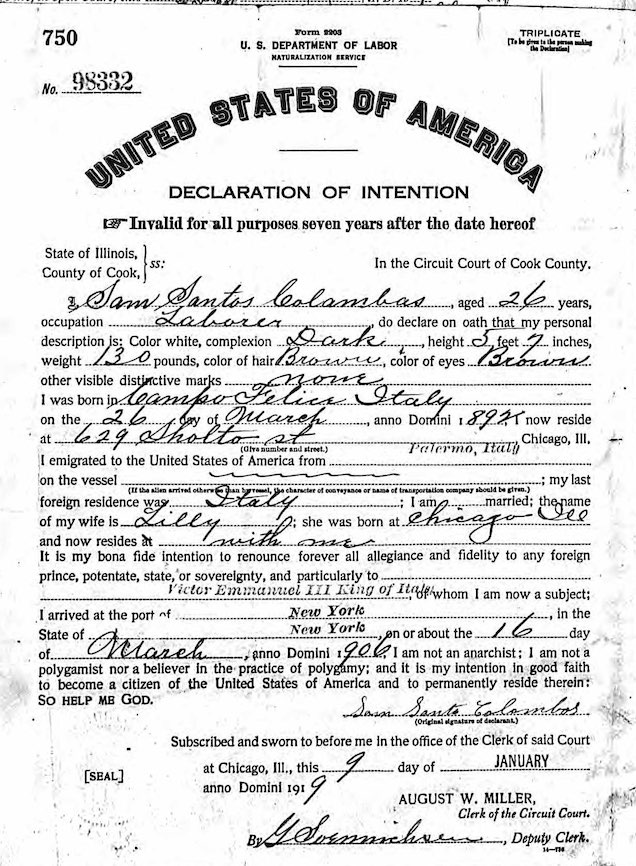Recently Ancestry.com released a new batch of immigration and naturalization records from Pennsylvania. Having family roots on both sides in that state, I had to take a look. I wasn’t expecting to find much, because I have most of the naturalization history already tracked for my immediate ancestors, but what I did find changed the story for one of them.
My story of my paternal grandfather, Sebastian Columbus, has been learned in pieces. He immigrated twice, both times alone. The first time, because he was a minor and wasn’t “claimed” at Ellis Island, he was sent back. He returned a year later, in 1907. The time between his arrival and his naturalization in 1944, 37 years later, has only slowly come into focus.
One question I’ve longed to have answered by something other than my imagination, is why did he take so long to make his citizenship official? He seemed to have no intent to ever return to Sicily, and as far as I know, never did. When he did finally get his citizenship – and legally change his name – it was at a high point in WWII, and three of his four sons were fighting in the war. For a long time, I’ve interpreted his actions, along with other factors, as patriotic, but perhaps that’s not the whole story. It turns out, much like his first attempt at immigration, his first attempt at citizenship, failed.
In January 1919 while he and my grandmother Lillian were still living in Chicago, he submitted a Declaration of Intent. Lillian had been born here, a year after her immigrant parents arrived. She was a US citizen until she married someone who wasn’t, so now they were both aliens. They were living at 629 Sholto (now known as Carpenter St.), a part of Little Italy, and the Letizia family was living only a couple blocks down the street. In September of that year, according to his later petition, they’d moved to Monessen, PA. That winter their first son was born, and just before my uncle’s first birthday in 1921, Grandpa petitioned for citizenship.
I can’t be certain, but I see his actions of becoming a citizen as a rather typical early 20th-century immigrant story, perhaps even an American dream tale. It’s like something out of a movie with a hero working his way to towards a better life, a film complete with music montages of the young couple and their new adventures, and underscoring music. But what’s a good story or film without some conflict, something getting in the way?
His petition was denied in 1923.

There’s no clear reason as to why it was denied, outside of the “petitioner has failed to prosecute petition”, but at least was done “without prejudice”, so he would be able to try again. Strangely, there’s a reference to petition number 24542, but it’s not his petition number, and when I finally found that petition, it belonged to an Englishman named James Winfield Bennett.
So I can only surmise….the denial might have been that there was no proof or record of when he immigrated. This event might’ve been hard to track down because A) his name wasn’t Sam Santos Colombos, it was Sebastian Santo Colombo and B) he didn’t successfully immigrate in 1906, as he claimed. To be fair, spelling doesn’t mean much, and he was essentially using the name Columbus, regardless of how it’s spelled or conflated with his actual surname.
As for “Sam”, well, he was married under the name Sam, and he completed the WWI draft under the name Sam. But he wasn’t able to get his citizenship under that pseudonym. Some day I’ll figure out why, when, and how, he mostly became known as Angelo.
It would be another 16 years before he would start over, using his real name. In these documents I found, there’s a 1939 certificate confirming his actual arrival.
Things were getting complicated in Europe in the 1930s, and by this point, he had four sons. In America, sentiment toward some European immigrants was becoming less-than-friendly (not that it had really been friendly, to begin with) and the US Congress passed the Nationality Act of 1940, which would classify him as an “alien enemy” unless he worked to become a citizen.
But Sebastian was a bit ahead of the curve this time because it was in January of that year when he once again submitted a declaration of intent. Then, in 1942 he completed his Petition for Naturalization, in 1943 he provided a certificate of loyalty, and finally, in May 1944 he became a citizen. Along with his naturalization, he petitioned the court for, and received, the legal name change to Sebastian Columbus.
Weeks after getting his citizenship, his second-born son, the one born during Sebastian’s first attempt at citizenship, would be injured in the D-Day invasion, and not survive. As a new American citizen, he experienced one of the ultimate sacrifices for his country.
Oh, and…the citizenship that Lillian lost by marrying him 27 years prior? It was never returned because she died in 1941 in the midst of this second attempt. Even though the law that took it away from her had been repealed she would’ve needed to also petition the government and there’s no sign that she ever applied for re-naturalization. Technically, she died without being a citizen. That should probably go in the movie too.

